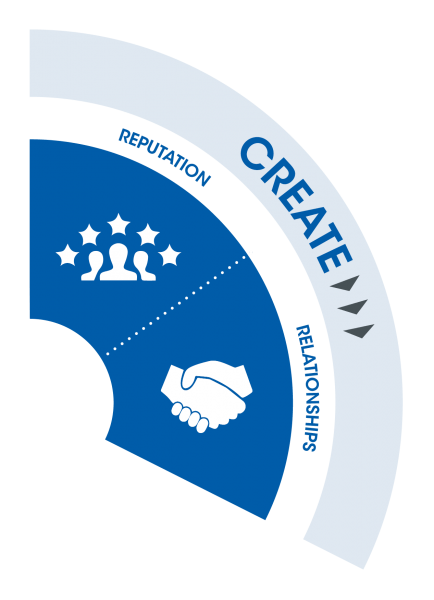Working together for better KAM
Chris Founds and Gary Williams look at harnessing the power of collaboration to achieve successful Key Account Management.
Collaboration is a word used more in business now than at any other time in our careers. Management teams use it when they want their organisations to break down so called ‘silos’ and employees use it when they need the help of others to achieve their objectives. Clients use it when they want us to work with fellow suppliers.
There is plenty of scope here for the cynic to suggest that the client’s motivators behind this call for collaboration are less than totally altruistic, in fact one might argue that the very nature of business is about being better than our competitors and all the focus is on differentiation and how to become No. 1.
There is of course more than an element of truth in this view, but it is possible to become hugely successful by developing a collaborative ethos at the heart of the organisation. One of the ways professional and engineering services firms collaborate internally by cutting across discipline‘ silos’ that hamper them is through a client management programme.
First of all let’s define what we are talking about.
- Collaboration: A working practice whereby individuals and/or organisations work together to a common purpose to achieve personal and business benefits.
- Key Account Management: Delivering services that meet or exceed client expectations whilst nurturing existing and building new relationships. Developing an understanding of the client that allows the supplier to help them achieve their objectives
In the table below is a list of ‘Habits of Highly Collaborative Organisations’ from a recent Forbes Magazine article. Below this we have added the principles of Key Account Management.
Highly collaborative organisations
Lead by example:
Employees follow their leaders, not so much what they say but how they behave. Most successful companies have a culture which is lived and breathed at the top.
Individual benefit vs Corporate benefit:
If it’s all about how the organisation will benefit as opposed to how this approach will help the individual, uptake will be slow and patchy at best.
Strategy before technology:
It is essential to have the mindset and the will in place before any technology platform.
Learn to get out of the way:
Guidelines and objectives are necessary but then we need to empower the individual. After all, collaborating with your fellow man is a purely human behaviour.
Create a supportive environment:
This encompasses remuneration and incentive schemes as well as training, mentoring and coaching. Too many firms reward individual behaviour over team behaviour.
Measure what matters:
Purely financial measures against an individual will drive certain (often divisive) behaviours. Measuring things like how many introductions are made internally and externally, for example, will drive different behaviours.
Persistence:
Don’t allow ‘Collaboration’ to become this year’s initiative and then move on to the next thing next year. To create a highly collaborative organisation it is essential to plan to change for good.
The principles of sound Key Account Management:
Executive sponsorship:
The programme has to have the backing and support of the executive. Without it any momentum will quickly diminish.
Capturing hearts and minds:
Individuals have to know what’s in it for them to invest time, effort and energy. In most cases there are no financial incentives and the success of the programme relies on the motivation of teams.
Systems and processes:
Whilst it is important not to make a KAM programme a ‘tick box’ exercise, it is important that everyone involved understands how KAM works and who is responsible for what, etc. Key Client Management training then becomes crucial. CRM systems can make the process work very efficiently and allow data to be shared easily, but the mind-set comes first.
Invest in creating a KAM culture:
When KAM works well, account teams believe they are there to protect and grow the clients in question and helping the client to achieve their goals overrules any internal ego and politics.
Measurement:
How will the account team (and the Exec) know if the programme is successful? Many firms make the mistake of only measuring output (increase in fees), without also measuring the inputs (e.g. number of new relationships, new services introduced, proactive ideas delivered, client feedback scores, etc.)
Meetings and momentum:
The team needs to meet regularly in order to maintain momentum, but these meetings can become monotonous and dull if all we are doing is looking back on what has happened since we last met. This information should be reported prior to the meeting to allow the focus to be on objectives and actions going forward.
Read more about the top five factors when establishing a new key account management programme: The Key To Growth: Key Account Management.
Key Client Management Training
Achieve great client retention and growth using a practical plan of action
Key Principles of Collaboration
The Institute of Collaborative Working (ICW) has defined key principles of collaboration set against a simple framework. There are three overriding principles that draw many parallels with Key Account Management:
- Common vision and leadership
- Right behaviours and culture
- Collaborative processes and tools
Let’s work together
So, successful collaborative working is as much about the behaviours and motivations of individuals as it is about bringing groups together to achieve a common purpose. This is absolutely true of any KAM programme where collaboration is vital in areas such as relationship mapping, common goals, team performance and adding value. It is key to the successful outcome of any project, framework or strategic partnership.
Working together and staying together are important aspects of collaborative working and very much core to the eight main objectives championed by the ICW which has led to the British Standard 11000 (now ISO 44001):
Phase 1 – Strategic objectives:
- Awareness
- Knowledge
- Internal Assessment
Phase 2 – Engagement objectives:
- Partner Selection
- Working together
- Value creation
Phase 3 – Management objectives:
- Staying together
- Exit Strategy
Accreditation for Collaboration
BS 11000 [now ISO 44001] reinforces what can be achieved through an accredited approach and says: “Effective collaboration will, over time, create an environment that engenders trust between organisations. This in turn will increase their ability to deliver joint efficiency improvements, challenge traditional working practices and explore new ways of working, enhance transparency and openness, strengthen their ability to challenge and innovate, understand and overlay each party’s governance and assurance processes.”
Collaboration as a factor in successful tendering
Recent procurement by a number of major national infrastructure organisations identified and sought to include collaboration as a new mandate. This required suppliers, consultants and delivery organisations to demonstrate their behaviours, cultures, values and how they have worked together collaboratively. This involved tenderers having to attend assessment centres where their approach to and competencies in teamwork and collaboration with other organisations were examined.
Executive sponsorship
Like any commitment of this type, to be successful requires a huge commitment from the Executive level down to those involved in delivery at a project level. The appointment of a Senior Executive responsible is a key step to securing senior level sponsorship, and coupled with clear objectives that have been mutually developed, this provides an excellent platform for collaboration.
Trust is the key-stone to collaboration
The essence of all relationships is that organisations (and individuals) learn from each other, build trust and become stronger, more rounded and progressive as a result.
So, collaborating, like key account management is all about working together to achieve a better outcome than we would achieve if we worked in isolation. Breaking down barriers, working out where synergies exist, admitting weaker areas and combining strengths can deliver incredible results.
The link between good Key Account Management and Collaborative working has never been stronger and those organisations who create a collaborative culture are more likely to be successful. This includes collaborating with clients in the pursuit of highly effective account management. Without their input we are in danger of simply ‘doing’ KAM to our clients in the hope it will lead to more opportunities. Where we embrace the ethos of collaboration from the outset with all stakeholders – internal and external, we can develop long-term profitable and rewarding relationships for all involved.

Gary Williams is the Managing Director at Questas Consulting Ltd, which provides Key Client Management and Client Account Planning training to professional and engineering firms.
Account management planning
Strategic and tactical approaches to client account management.

Download your free guide to grow your key account management skills.








